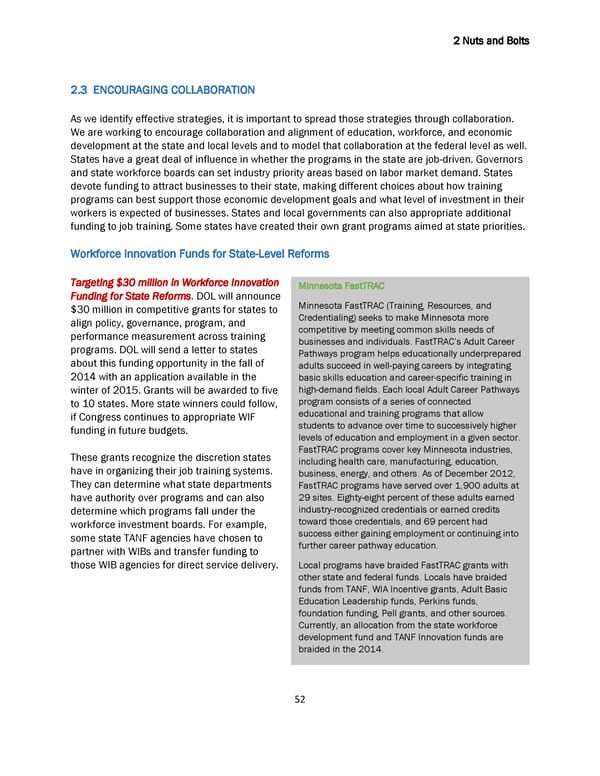2 Nuts and Bolts 2.3 ENCOURAGING COLLABORATION As we identify effective strategies, it is important to spread those strategies through collaboration. We are working to encourage collaboration and alignment of education, workforce, and economic development at the state and local levels and to model that collaboration at the federal level as well. States have a great deal of influence in whether the programs in the state are job-driven. Governors and state workforce boards can set industry priority areas based on labor market demand. States devote funding to attract businesses to their state, making different choices about how training programs can best support those economic development goals and what level of investment in their workers is expected of businesses. States and local governments can also appropriate additional funding to job training. Some states have created their own grant programs aimed at state priorities. Workforce Innovation Funds for State-Level Reforms Targeting $30 million in Workforce Innovation Minnesota FastTRAC Funding for State Reforms. DOL will announce Minnesota FastTRAC (Training, Resources, and $30 million in competitive grants for states to Credentialing) seeks to make Minnesota more align policy, governance, program, and competitive by meeting common skills needs of performance measurement across training programs. DOL will send a letter to states businesses and individuals. FastTRAC’s Adult Career about this funding opportunity in the fall of Pathways program helps educationally underprepared adults succeed in well-paying careers by integrating 2014 with an application available in the basic skills education and career-specific training in winter of 2015. Grants will be awarded to five high-demand fields. Each local Adult Career Pathways to 10 states. More state winners could follow, program consists of a series of connected if Congress continues to appropriate WIF educational and training programs that allow funding in future budgets. students to advance over time to successively higher levels of education and employment in a given sector. These grants recognize the discretion states FastTRAC programs cover key Minnesota industries, have in organizing their job training systems. including health care, manufacturing, education, business, energy, and others. As of December 2012, They can determine what state departments FastTRAC programs have served over 1,900 adults at have authority over programs and can also 29 sites. Eighty-eight percent of these adults earned determine which programs fall under the industry-recognized credentials or earned credits workforce investment boards. For example, toward those credentials, and 69 percent had some state TANF agencies have chosen to success either gaining employment or continuing into partner with WIBs and transfer funding to further career pathway education. those WIB agencies for direct service delivery. Local programs have braided FastTRAC grants with other state and federal funds. Locals have braided funds from TANF, WIA Incentive grants, Adult Basic Education Leadership funds, Perkins funds, foundation funding, Pell grants, and other sources. Currently, an allocation from the state workforce development fund and TANF Innovation funds are braided in the 2014. 52
 Biden Ready to Work White Paper 7/22/14 Page 51 Page 53
Biden Ready to Work White Paper 7/22/14 Page 51 Page 53